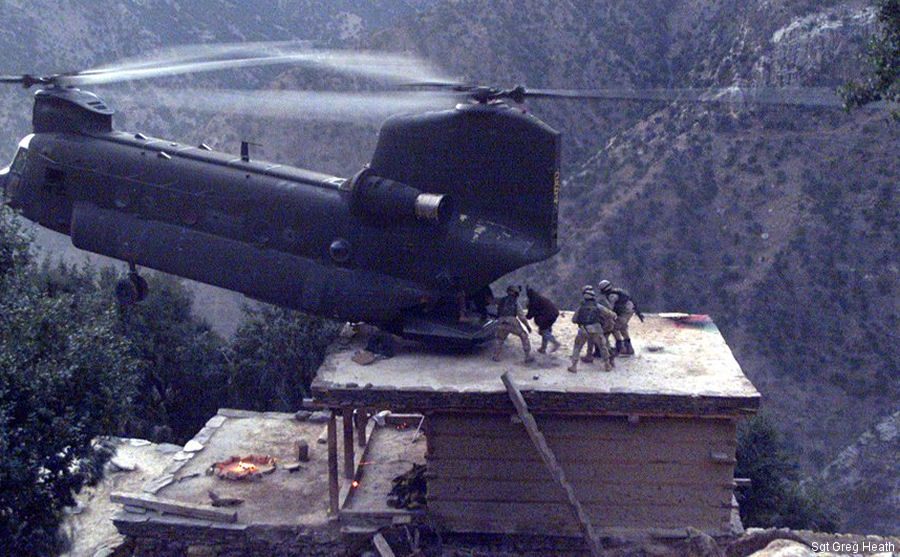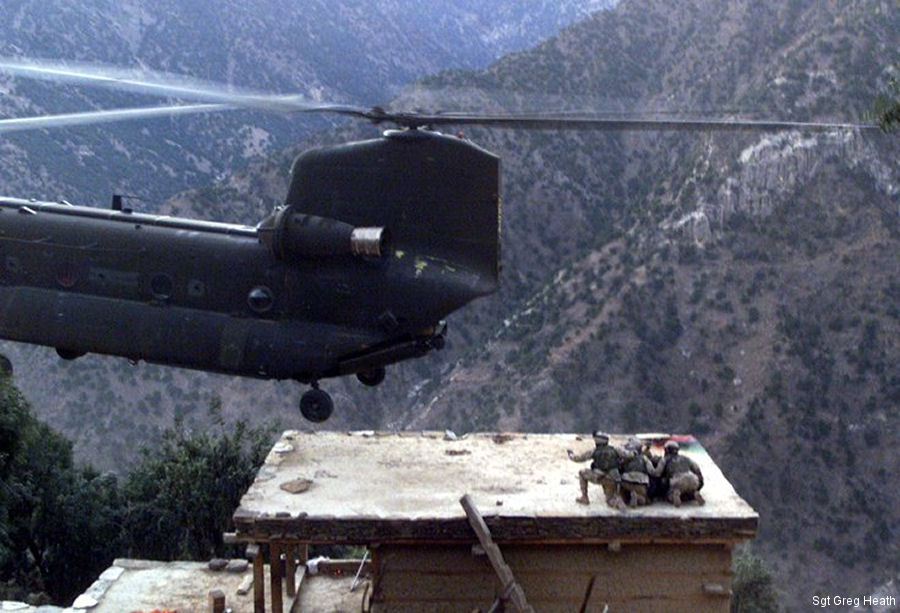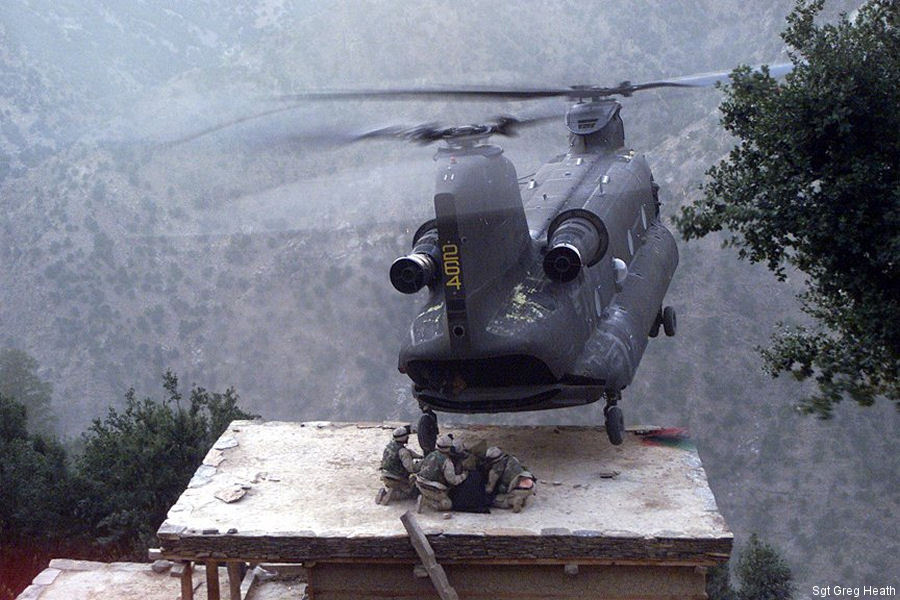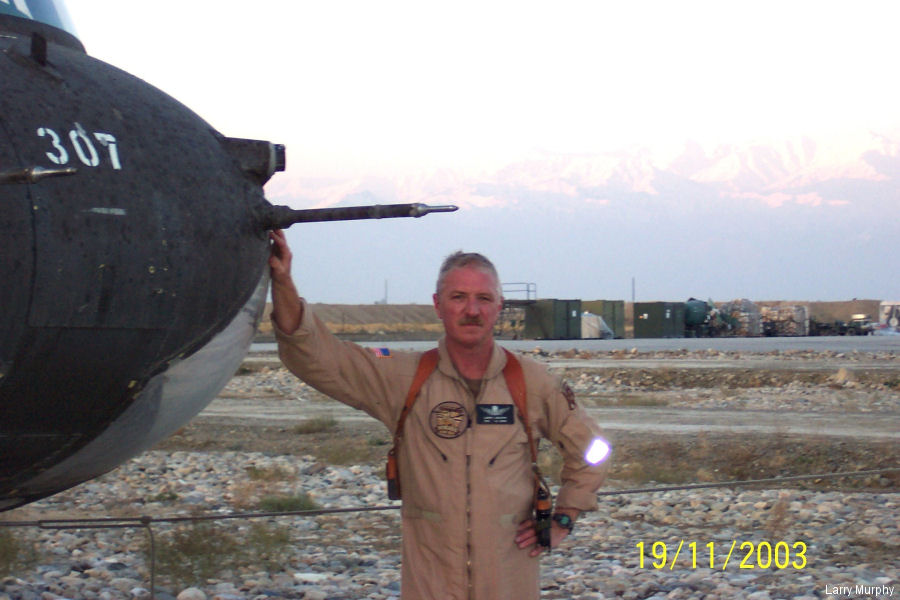
The two pilots, members of the Pennsylvania National Guard’s Company G, 104th Aviation Regiment, responded to the location, a village on the side of a steep mountain. Soldiers from the Army’s 10th Mountain Division had detainees in custody that needed to be transported to Bagram Airfield.
With no other landing zones available, Murphy landed the helicopter’s two rear wheels on the roof of a small house while keeping the front wheels hovering to allow the Soldiers to load the detainees into the back of the aircraft.
Nearby, Army journalist Sgt. Greg Heath – a Delaware County, Pennsylvania, native – snapped a photo of the helicopter’s precarious perch atop the house. That photo has since become one of the most well-known photos of the 20-year conflict in Afghanistan.
While the photo of the landing has gone viral, Murphy said in actuality, it wasn’t that difficult of a maneuver.
“It was just another day on the job,” he said. “We didn’t think anything about it at the time. It was a little bit of a job getting it on there, but nothing we hadn’t done before.”
‘A call on the net’
Company G was made up of about 200 Soldiers from the Pennsylvania and Connecticut National Guards. The Pennsylvania contingent was based at Fort Indiantown Gap.
The unit was initially mobilized to deploy to Iraq but was rerouted to Afghanistan, where it was based at Kandahar Airfield in the south of the country.
In late October, part of the unit was forward-deployed to Bagram Airfield to support the 10th Mountain Division’s Operation Mountain Resolve in the mountainous region of northeastern Afghanistan.
After flying the 10th Mountain Soldiers in for the initial infiltration, the forward-deployed crews from Company G spent the next several days conducting resupply missions.
It was during one of those resupply missions that Murphy and Barnes’ helicopter, call sign Yankee 2-6, got the call to evacuate the detainees.
“We were just doing routine operations,” said Muphy, the aircraft’s pilot-in-command. “It wasn’t only us. Many of our aircraft were in that area doing operations. We got a call on the net, and they said, ‘We got some people here we need to extract. Can you come and help us out?’”

Group effort
When they arrived on scene, Murphy and Barnes observed that there weren’t any real landing zones available in the village. The roof of the house was pretty much the only option, Murphy said.
The elevation was about 8,500 feet, and the house was about 1,500 to 2,000 feet above the valley floor, Murphy said.
“We took a look at it and saw that we had blade clearance on the trees, and we can sneak it in there,” Murphy said. “It looks pretty tenuous putting a 50,000-pound aircraft on a mud hut, but if you look at it, it’s a fairy sturdy structure.”
A two-wheel landing is a normal operation for a Chinook, and is known as a pinnacle landing, Murphy said.
“What was different about this is where they chose to make that two-wheel landing,” he said.
Barnes, the co-pilot, made the first attempt to put the wheels down on the roof.
“I tried it at first, but after a couple minutes, I was a little pre-occupied with putting the landing gear through the roof,” Barnes recalled. “I didn’t know how much it would hold, so Larry took it over and did an expert job, as always, and we got it done.”
While the pilots may get the credit for the landing, Murphy credits the helicopter’s crew for their role in guiding the aircraft onto the roof.
“When it comes to close to the ground operations, we don’t have rearview mirrors,” Murphy said. “I don’t know what that aircraft is doing 75 feet behind me, so I got a flight engineer or a crew chief, and we train together, and we practice working together. In operations like pinnacle landings, they are basically flying the aircraft by verbal remote control.
“So, I got a guy that’s back there, he’s out on the ramp and he’s saying, ‘Left two, down five, down one, over four,’” he added. “I can get it in the general area, and he verbally guides us down from there.”
The other members of the helicopter’s crew were Sgt. 1st Class Jim Duggan, Sgt. Brian Kilburn and Spc. Margaret Haydock. Murphy, Barnes and Haydock were from Pennsylvania; Duggan and Kilburn were from Connecticut.

‘All in a day’s work’
Murphy said part of the reason he was able to easily execute the landing was his experience as a pilot. At the time, Murphy was a full-time EMS pilot outside the Guard and was employed by Keystone Helicopters, which provided EMS helicopters to several hospitals in eastern Pennsylvania.
“To get a coordinate to go to, for me being an EMS pilot, was all in a day’s work,” Murphy said. “That’s what most helicopter pilots do.”
Many of the pilots in Company G had experience as pilots outside of the Guard, Murphy said. Additionally, several of the unit’s pilots had combat experience flying Hueys in Vietnam, he said.
“Our average pilot age was in the early 40s and our average flight hours was over 3,000,” Murphy said. “We were replacing the 101st, and other active-duty units were similar, where their average age was 28, and their average flight time was 600 to 800 hours.”
Murphy, who had 39 years of service between active duty and National Guard, retired in 2013 a as a chief warrant officer 4. He now lives in North Carolina.
Barnes said the rooftop landing was a common maneuver, and they practiced them regularly.
“A slope landing is normally what we call it, or a pinnacle landing, and we practiced all the time,” Barnes said. “As a matter of fact, the day before, I did a one-wheel landing on a mountainside picking up a guy with a broken ankle. It’s just part of what we did. You got to work with the terrain.”
Unlike Murphy, Barnes did not have piloting experience outside of the military. At the time, he worked as an IT manager for a construction company.
Barnes retired in 2004 as a chief warrant officer 4 after 21 years in the military, the last 17 in the Pennsylvania National Guard. He now lives in Grantville, Pa., a short distance from Fort Indiantown Gap.
‘A cool memory’
As the saying goes, a picture is worth a thousand words, and the photo of Murphy and Barnes’ Chinook hovering above that mountainside house, spoke to many people.
It has appeared in numerous news articles over the last two decades, has been the subject of internet memes and was immortalized in a painting by noted combat artist Larry Selman.
“The only reason all this happened is because there was a combat cameraman with that unit who happened to catch this point in time,” Murphy said. “The things that I had done on that deployment, that was probably the third or fourth most complicated thing that I did, but there was nobody to capture the other ones.”
Barnes said he didn’t think the mission was noteworthy until a few days later when someone showed him the photos.
“When we got back to Bagram, the flight surgeon that was with us said, ‘Hey, you gotta see these pictures,’ and he gave me a thumb drive with them on it,” Barnes said. “I sent one to my wife, and it just blew up from there.”
Barnes said he enjoys the occasional reminders of the mission.
“Just about every year it pops up or somebody sends it to me,” Barnes said. “I saw it on a book cover, so I read the book, but there was nothing in it about that mission. It’s a cool memory to have and a little 15 minutes of fame thing.”

CH-47D Chinook 91-00264 ( US Army Aviation )
See also |
M/CH-47D/E Chinook in




